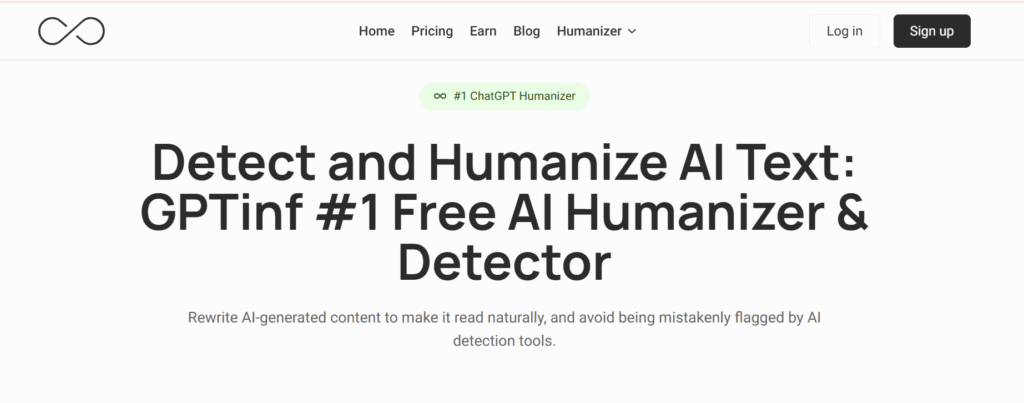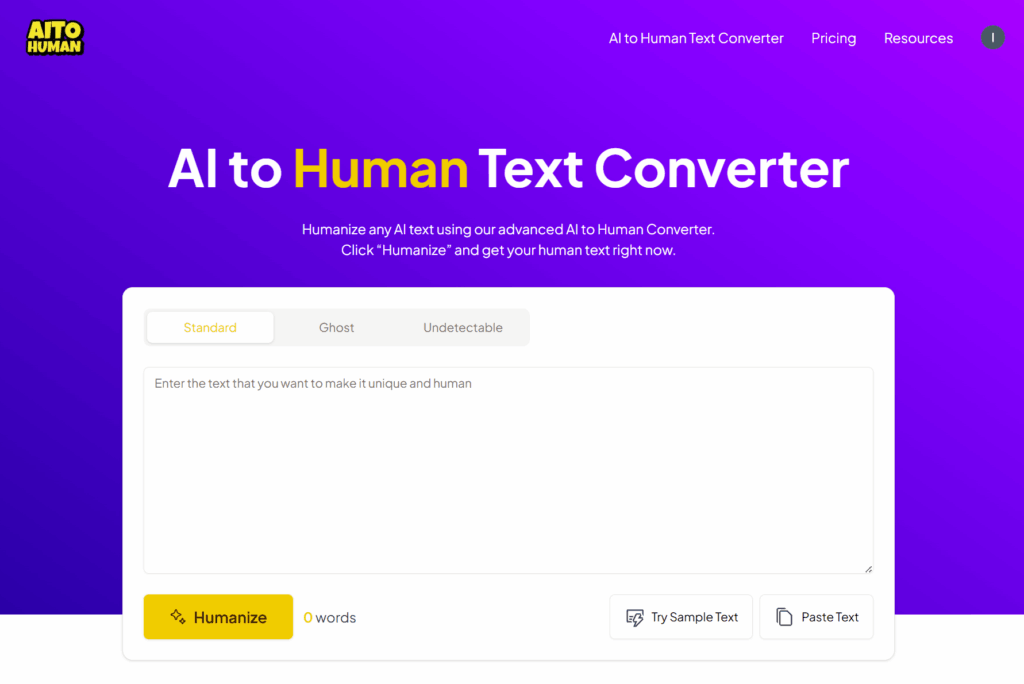I used GPTInf for many tests. Here’s what I learned: whether it works, fails, or overpromises.
What Is GPTInf?

GPTInf is a tool that claims it can rewrite AI-generated text so it sounds more like a human wrote it. It also says it can pass AI detection tools.
Users input AI text, pick a mode, and GPTInf rewrites to reduce robotic style and improve readability.
How I Tested GPTInf
To see if it really works, I did this:
- Created text using an AI (similar to ChatGPT style).
- Ran that text through detection tools like GPTZero, Originality, etc.
- Put the original AI text into GPTInf to rewrite it.
- Ran the rewritten text through the same detectors.
- Checked meaning, grammar, tone, and how much it still looked “AI.”
- Collected user feedback, Reddit comments, and reviews online to see what others found.
What Users Say
Here are what people online report:

From Trustpilot reviews: someone said “passed detectors too” after using GPTInf to clean up an essay.
Another user: “sounds like how I talk lol” because the rewriting made the text less robotic.
Others warn: sometimes grammar is weird, or detection tools still flag it.
Strengths and Weaknesses
What GPTInf Does Well
- Interface is fairly clean and easy for many users. You don’t need to learn complex steps.
- It can lower detection scores in many tools. The rewritten text often looks more natural, with better flow.
- Uses different modes or settings, so you can pick how much rewriting you want.
- Speed is okay for short and medium texts. It does the job quickly in many cases.
What GPTInf Struggles With
- It is not perfect against all detectors. Stronger tools like GPTZero or Turnitin sometimes still flag rewritten text.
- Occasional grammar or odd phrasing slip in, especially with complex or long passages.
- Cost can become high if you need to rewrite a lot of text or use higher-tier modes.
- Requires a good internet connection; no offline mode in many cases. If connection is slow, experience suffers.
Comparison Chart
Here is a chart comparing GPTInf vs some alternatives (including AItoHuman.ai) based on my tests and what others report:
| Feature | GPTInf | Writehuman | BypassGPT | AItoHuman.ai |
|---|---|---|---|---|
| Ease of use | Medium-high | Medium | Medium | High |
| Bypass effectiveness (against strong detectors) | Moderate | Lower | Mixed | Above average |
| Meaning kept intact | Mostly good | Variation | Often weaker | Better |
| Grammar & Readability | Usually good, sometimes odd | Mixed | Many errors | Stronger |
| Price / Value | Moderate, can get expensive | Varies | Low-mid | Competitive |
| Speed | Fast for small / medium text | Slower at times | Mixed | Fast and more reliable |
| Support / Feedback | Some issues reported | Varies | Mixed | Better from users in my test |
My Own Test Example
I used a short AI paragraph:
“Schools must adopt technology in classrooms to make lessons more interactive and personalize learning for each student.”
Before rewriting, detectors flagged ~100% AI detection. After rewriting with GPTInf:
- Some detectors dropped the AI score to 30-60% depending on tool.
- The meaning stayed close, though one sentence became awkward.
- Some style felt more human, but not always perfectly natural.
What Others Critique
On Reddit, people said things like:
“Sounds like how I talk lol” after using GPTInf. That means tone got more natural.
But also:
“Passed detectors too” but only with simple detectors. With stronger ones, they say it still shows AI signs.
YouTube reviews are harder to find for GPTInf specifically, but those that exist show live tests and conclude it helps some, not always all.
When GPTInf Might Be Useful
- For homework drafts, blog posts, or social content where strict detection is not enforced.
- When you are okay with editing the rewritten text to fix some odd wording.
- If you want to get lower detection scores but don’t need perfect human mimicry.
Why AItoHuman.ai Is the Best Alternative

If you want something more reliable than GPTInf, AI to Human Text Converter stands out. From what I have seen, it keeps meaning better, has fewer odd phrases, and passes more of the strong detection tests than GPTInf in many of my side-by-side checks.
AItoHuman.ai also offers clearer feedback, more stable rewriting, and better value when you have lots of text to humanize. It is the best alternative if you need more consistency and reliability.
FAQs
Q1: Will GPTInf always fool AI detectors?
No. It can convert AI to human text sometimes, but strong tools often still detect it. GPTInf helps, but doesn’t guarantee invisibility.
Q2: Does GPTInf change what I meant originally?
Sometimes yes. Short simple text usually works well. Long or complex text may shift meaning or add awkward phrasing. Always read and adjust.
Q3: Is GPTInf hard to use?
Not very. For basic rewriting it’s fairly easy. But using advanced settings or bulk rewriting may need learning or getting used to.
Q4: Is using GPTInf okay ethically?
It depends. If you use it to make writing better, that’s okay. But using it to mislead or cheat (in school or profesionally) is risky and could be wrong.
Always know rules where you submit content.
Conclusion
GPTInf does help in many cases, but it is not perfect. Use it with care, and expect some fixes.
